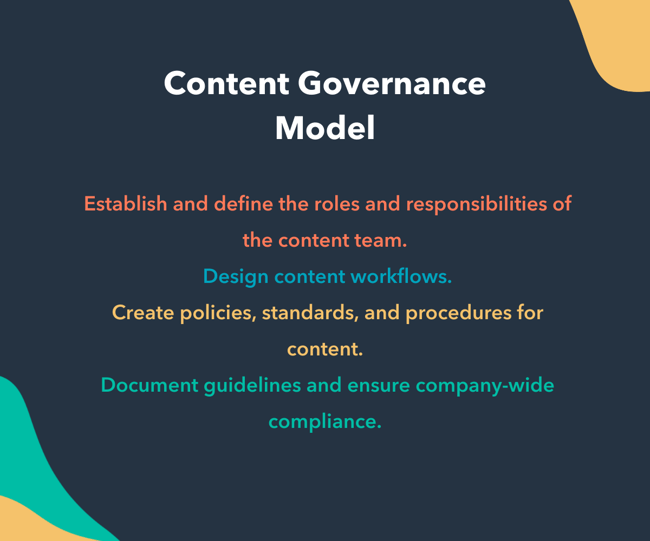
Without a content governance model in place, your content marketing efforts can seem scattered and chaotic, opening the opportunity for your audience to replace you with a competitor.
Content governance keeps your relationship with your customers thriving, and allows you and your team to more effectively focus on your content goals.
In this post, we’ll cover the topic of content governance — what it is, why it’s important, and how you can create a model for your business.
What is content governance?
Content governance is the framework and processes your company uses to manage its content and determine how you create, publish, and maintain it. It defines priorities, provides guidelines, and assigns ownership to people within an organization to execute your company’s content strategy.
The goal of a content strategy is for your company to create meaningful and engaging content that aligns with your business objectives and drives consumers to a particular action. Content governance ensures that you have a definitive way for this content to reach them. Who creates the content? On what platform is it published? How will it be updated in the future? While these questions and their answers help shape content governance, its framework involves more.
Content governance is more than consumer-facing content. It requires preliminary and behind-the-scenes work seen in an asset like an editorial content calendar. Consumers don’t have access to your company’s content calendar; however, this is an irreplaceable tool to keep your company on track with its strategy. Style guides and content audits are other tools that assist with content governance but are unseen by consumers.
Content governance encompasses content sent to consumers and content that waits for them. It is not only reserved for social media posts that land on their feed or emails sent to their inbox. It includes banner ads or frequently asked questions on your website. It’s your Instagram bio or the answering message you have for phone calls. In a business, content is everywhere, and content governance allows your business to manage all of its avenues.
Why is content governance important?
To illustrate the importance of content governance, let’s look at an analogy.
Content marketing is like a first date. You wine and dine with visuals and information and hope it builds a budding relationship. If it does, how do you move forward and keep building?
After that initial interaction, you publish two emails, one blog post, and four social media posts during week one. You drop the ball in week two. The amount of content decreases to one email and two social media posts. Week three is worse, but during week four, you’re able to publish three emails, two blog posts, and five social media posts. While the increase in content seems remarkable, your potential long-term customer has unsubscribed from your content after a month. Why?
Content needs to be governed by procedures and systems. Procedures mean consistency, and consistency is key to the success of any business. It shows effort and demonstrates to customers that you care.
Content works as a cycle. Although the number of steps might differ for each organization, content life cycles typically follow this process:
- Develop a strategy.
- Create the content.
- Store the content.
- Edit.
- Publish.
- Analyze.
- Update or repurpose content.
The content cycle never ends. There is always work to do. Use the steps above. If you finish strategizing, focus on content creation. If you’re not creating, your company can work on storing, editing, publishing, and more.
Content governance is important because it ensures that your company maintains an efficient process in its continuous content cycle. It can prevent delays, inconsistent messaging, or even legal issues. Content governance helps:
- Provide structure
- Establish clear roles and responsibilities
- Create detailed processes and workflows
- Outline company standards and policies
A comprehensive content governance model creates a standard for effective, consistent content, resulting in continued success.
Content Governance Model
A content governance model is a plan that helps your company execute its content strategy. It is a combination of people, processes, and policies that allows you to guide your content.
The online world is fast-paced, and to keep up, businesses need to make sure that they’re covering all avenues. It used to mean website and email content; however, the growth of social media has expanded the number of channels businesses need to account for. Companies have had to shift gears and adjust their content strategies to accommodate social platforms like Facebook, Instagram, and LinkedIn.
While content grows and changes, its governance models help companies scale, sustain, and recreate their content.
Creating a Content Governance Model

You’re ready to create your content governance model. While each step might require extensive work, the process isn’t complicated. Building your content governance model requires four steps.
- Establish and define the roles and responsibilities of the content team.
- Design content workflows.
- Create policies, standards, and procedures for content.
- Document guidelines and ensure company-wide compliance.
Let’s go over these one-by-one.
1. Establish and define the roles and responsibilities of the content team.
Good content doesn’t exist without people. While you could argue that the most vital person in the content experience is the consumer, you could also contend that content would not exist without the team.
To create a content governance model, decide on the roles and responsibilities of those within the company. Content roles include strategists, writers, editors, and analysts. When defining the obligations of the people in these roles, think about their function. Team members typically have a strategic, operational, or specialist function.
A strategic function, usually seen in roles like a content strategist, is for those who plan long-term strategy. Staff, who are operational, implement the content strategy daily. This work is carried out by writers, editors, photographers, and more. Lastly, members of the specialist function provide expert data to other team members. This could be an SEO specialist providing analytical information to strategists or writers that shape how they fulfill their role.
When establishing the roles and responsibilities for your team, you might find it necessary to create an overlap in function. For example, it could be beneficial to have your content writers specialize in SEO. As long as there is a clear distinction in role and responsibility, there should be no issue in team management.
2. Design content workflows.
How does your content go from Point A to Point B? Point A is an idea while Point B is publication. Consumers cannot see this process, but multiple steps are necessary to reach publication.
Content workflows follow these stages:
While the list is short, the process isn’t. Content takes time. Once you’re aware of what it takes to create your content, use this to shape your policies, standards, and procedures.
3. Create policies, standards, and procedures for content.
Once you have the proper people in place, it is time to focus on your policies, standards, and procedures. Content policies are the values and goals of a company. Standards are targets used to make sure that a company upholds its policies. Procedures are a step-by-step breakdown of who is involved and what steps are needed to achieve the ultimate goal.
Consider this example. An online company has the policy to be a leading source of global news. The company enforces this policy by setting a standard for publishing at least 10 daily articles. Members of the content team, like the writers, editors, and publishers, have procedures to guide them through the content process and ensure that 10 articles are shared with the public every day.
Once your company creates policies, standards, and procedures for content, finish the process with documentation and compliance.
4. Document guidelines and ensure company-wide compliance.
There is no use in creating a content governance model if no one knows about it. The most significant element of content governance is ensuring that the entire company has access to it and complies with it.
Create documents for your company policies, standards, and procedures, and put them in a central location. Hold a meeting to walk through content processes and workflows. And lastly, regularly review and update your content governance models.
Content never ends.
Content lives on a lifecycle. You might think a blog post is complete after it is published and distributed, but its cycle continues with updates and redistribution. Managing one blog post without a system is most likely doable, but imagine an additional 20 content assets in one week. Scary, right?
Without any checks and balances, creating and managing your content can become chaotic. Content governance prevents this. With a content governance model in place, your company will have the framework and processes in place to successfully execute your content strategy.





